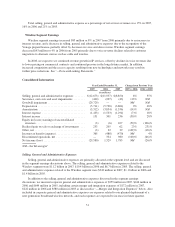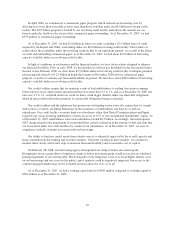Sprint - Nextel 2007 Annual Report Download - page 59
Download and view the complete annual report
Please find page 59 of the 2007 Sprint - Nextel annual report below. You can navigate through the pages in the report by either clicking on the pages listed below, or by using the keyword search tool below to find specific information within the annual report.costs are impaired whenever events or changes in circumstances cause us to abandon such assets if they are no
longer needed to meet management’s strategic network plans. Software development costs are impaired when it
is no longer probable that the software project will be deployed. For the year ended December 31, 2007, we
recorded an after-tax impairment charge of $103 million primarily related to the abandonment of certain iDEN
cell sites under construction. For the year ended December 31, 2006, we recorded an after-tax impairment charge
of $43 million primarily related to software asset impairments and abandonments of various assets, including
certain cell sites under construction. For the year ended December 31, 2005, we recorded an after-tax impairment
charge of $27 million primarily related to the write-off of various software applications. We also periodically
assess network equipment that has been removed from the network to determine if an impairment charge is
required. If we continue to have challenges retaining iDEN subscribers and as we continue to assess the impact of
rebanding the iDEN network, management may abandon certain iDEN assets in future periods if we conclude
those assets will either never be deployed or redeployed, in which case we would recognize a non-cash
impairment charge that could be material to our consolidated financial statements.
Valuation and Recoverability of Goodwill and Indefinite Lived Intangible Assets
Intangible assets with indefinite useful lives represented $22.1 billion of our $64.1 billion in total assets as
of December 31, 2007. We have identified FCC licenses and our Sprint and Boost Mobile trademarks as
indefinite lived intangible assets, in addition to our goodwill, after considering the expected use of the assets, the
regulatory and economic environment within which they are being used, and the effects of obsolescence on their
use. We review our goodwill, which relates solely to our wireless reporting unit, and other indefinite lived
intangibles annually in the fourth quarter for impairment, or more frequently if indicators of impairment exist.
We continually assess whether any indicators of impairment exist, which requires a significant amount of
judgment. Such indicators may include, a sustained significant decline in our share price and market
capitalization; a decline in our expected future cash flows, a significant adverse change in legal factors or in the
business climate; unanticipated competition; the testing for recoverability of a significant asset group within a
reporting unit; and/or slower growth rates, among others. Any adverse change in these factors could have a
significant impact on the recoverability of these assets and could have a material impact on our consolidated
financial statements.
When required, we first test goodwill for impairment by comparing the fair value of our wireless reporting
unit with its net book value. If the fair value of the wireless reporting unit exceeds its net book value, goodwill is
not deemed to be impaired, and no further testing would be necessary. If the net book value of our wireless
reporting unit exceeds its fair value, we perform a second test to measure the amount of impairment loss, if any.
To measure the amount of any impairment loss, we determine the implied fair value of goodwill in the same
manner as if our wireless reporting unit were being acquired in a business combination. Specifically, we allocate
the fair value of the wireless reporting unit to all of the assets and liabilities of that unit, including any
unrecognized intangible assets, in a hypothetical calculation that would yield the implied fair value of goodwill.
If the implied fair value of goodwill is less than the recorded goodwill, we record an impairment charge for the
difference.
During the period from our annual 2006 goodwill impairment assessment through the third quarter 2007, we
periodically analyzed whether any indicators of impairment had occurred. As part of these periodic analyses, we
derived the estimated equity value of the wireless reporting unit, which we then compared to its net book value.
Specifically, we reduced our stock price by the estimated value per share of our Wireline reporting unit and then
added a control premium, as permitted by FASB guidance, to determine an estimate of the equity value of the
wireless reporting unit. As the estimated fair value of the wireless reporting unit was higher than its net book
value during each of these periods, no additional testing was necessary.
In the fourth quarter 2007, we conducted our annual assessment of goodwill for impairment. During this
quarter, we experienced a sustained, significant decline in our stock price. The reduced market capitalization
reflected the Wireless segment’s lower than expected performance, due in large part to fewer than expected net
57
























